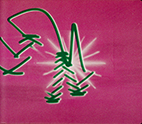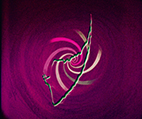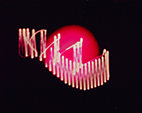Abstronic - Mary Ellen Bute
- Unseen Cinema Collection |
- 1952 |
- 7 minutes |
- COLOR |
- SOUND
Rental Format(s): Digital File
Co-makers: Mary Ellen Bute and Ted Nemeth
Original format: 35mm sound film 1.37:1
Music: Don Gillis and Aaron Copland
Courtesy: Mary Ellen Bute, Theodore Nemeth, Yale Film Study Center
Technical note: Slightly red faded 35mm projection print
I wanted to manipulate light to produce visual compositions in time continuity much as a musician manipulates sound to produce music. It was particularly while I listened to music that I felt an overwhelming urge to translate my reactions and ideas into visual form that would have the ordered sequence of music. -Mary Ellen Bute 1954
"Beautiful Lissajous curves, can be put through a choreography that inspires - and startles - the imagination," writes Mary Ellen Bute of her quest to visualize invisible rhythms. In Abstronic, she uses a cathode ray oscilloscope combined with conventional animation techniques and two tart musical numbers to generate a lively "seeing-sound" experience. -Bruce Posner
Infatuated with the new non-objective paintings of Kandinsky and others, Texas debutante Mary Ellen Bute (1906-1983) devoted twenty years (1932-1952) to creating thirteen abstract motion pictures in black-and-white and color, with familiar classical music accompaniments. Many were shown at New York's Radio City Music Hall. In 1966, she made a feature based upon James Joyce, Passages from Finnegan's Wake. -Cecile Starr
Before filming Mary Ellen Bute's short abstract films (1931-1953), Theodore "Ted" J. Nemeth (1911-1986) learned his craft creating special effects for feature film "trailers." As head of his own New York studio, founded in 1940 the year Bute and he were married, he made documentaries, commercials, and short subjects, two of which were Academy Award nominees. - Aram Boyajian







